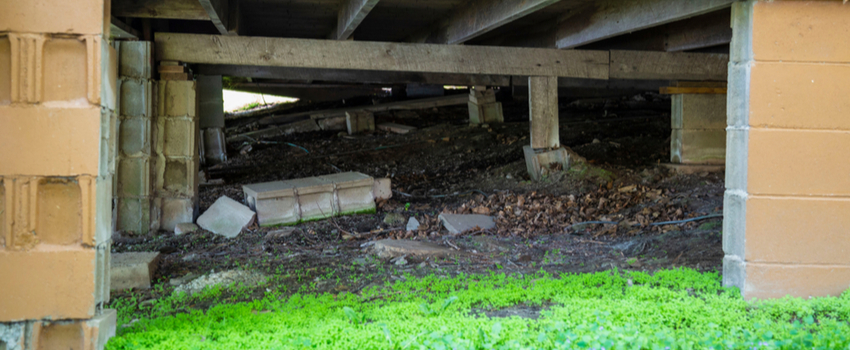It’s not uncommon for gulf coast homes to have pier & beam foundations. They have advantages but also require regular maintenance. If you’re thinking about buying a home with this type of foundation, you’ll want to consider the pros and cons that come with it.
Here’s everything you need to know about pier & beam foundations, along with how it compares against other types.
What is a Pier & Beam Foundation?
A pier & beam foundation is similar to a concrete one, with a few noticeable differences. The concrete slab is raised around 18” off the ground and reinforced with rebar (steel rods). The rebar forms a cage inside of the pier to support the attached structure. Older homes in Texas may use wood beams instead of rebar to support the pier foundation.
The small crawlspace underneath the foundation is used to house the utility connections for the home’s plumbing and electricity. It’s one of the advantages and downsides of a pier & beam foundation. The connections are easy to reach, but they’re also exposed to flooding. It’s one of the pros of having a post and beam foundation, but also a con.
A pier & beam foundation is similar to a concrete one, with a few noticeable differences. Built 18” or more off the ground, pier & beam homes are supported by poured concrete piers. Beams (typically wooden) are placed on top of and fastened to the piers. The floor is then built on the beams.
The small crawlspace underneath the foundation is used to house the utility connections for the home’s plumbing and electricity. It’s one of the advantages and downsides of a pier & beam foundation. The connections are easy to reach, but they’re also exposed to the elements. It’s one of the pros of having a post and beam foundation, but also a con.
Pier and Beam Foundation Pros
Here are a few reasons why it may make sense to have a pier and beam foundation installed.
Stability Over Time
Pier and beam foundations vs. slab provide excellent stability in loose, sandy soil. Slab foundations can shift on soft ground, while pier and beam foundations remain stable.
Less Likely to Flood
Parts of Texas are prone to flooding, especially in coastal areas. A pier and beam foundation elevates your home to prevent floodwaters from seeping in. It’s one of the primary reasons this type of foundation is prevalent in areas prone to flooding.
Easy Access to Utilities
The 18” or so of space between the ground and foundation makes it easier to work on wiring and plumbing problems. The easy access shows up on the lower repair bills. Concrete slab foundations often require drilling or tunneling to get to the problem area.
Pier and Beam Foundation Cons
Pier and beam foundations come with a few downsides. For some home buyers, it’s not a deal-breaker, but it’s something to consider.
Creaky Floors
How the floors feel and sound can tell you if it’s a pier and beam vs. a slab foundation. The flooring is firmer and quieter with a slab. The raised pier and beam foundation allows floorboards to shift, creating the telltale creaking noise. If your floors are sagging, it can indicate a pier and beam foundation problem.
Mold and Mildew
The small crawl space is nice, but it can also create problems without maintenance. The humid weather is a breeding ground for mold and mildew that can build up underneath the foundation. Along with creating an unpleasant odor, it can also be a health hazard. Prevent this by having proper grading, drainage, and good airflow to evaporate standing water.
Crawl Space Vermin
Living in Texas, hearing the possibility of a vermin infestation can be a nightmarish scenario. You’re not sure what critter may decide to move into your crawl space. Along with carrying potential disease, rodents and insects can damage plumbing pipes and electrical wiring.
Signs of Pier and Beam Foundation Problems
Pier and beam foundations are durable and stable, but they can develop problems. Maintenance can eliminate or reduce your risk, but it’s a good idea to know what to look for before a problem turns into an expensive repair.
Foundational problems are the same for pier and beam as other types. Cracks where the wall meets the ceiling may be a sign the foundation is starting to shift. You also want to keep an eye on the piers. Along with insect and weather damage, the piers can start to sink.
Pier and Beam Foundation vs. Slab Foundation
Texas homeowners don’t always agree when it comes to a pier and beam foundation vs. a slab. Each one is best in specific circumstances, primarily the weather and soil conditions. Pier and beam foundations work best in areas with loose soil or are known to flood.
Contact URETEK Today for Foundation Repair in Houston
Pier and beam foundations are durable and provide stability for years. They also require maintenance and may need occasional repair. Whether it’s cracks in the wall, mildew, or sinking beams, the professionals at URTEK are here to help.
URETEK ICR Gulf Coast has the experience homeowners, and new buyers want. We specialize in Houston pier and beam foundation repair, along with other types of foundations.
Contact the experts at URETEK today for a free consultation.


